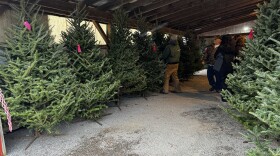Every year Christmas tree farmers lose a portion of their crop to a fungus that attacks the root of the tree. One tree farm in the Southern Tier has started planting a species that seems to be more resistant to the disease.
Dave Weil of Empire Evergreens in Painted Post, near Corning, is putting the final touches on a Christmas tree he has just sold.
“This is the final product. Ten years of work have gone into this moment when we hand it off to the customer and they can take it home and put it in their living room,” Weil said.
After years of hard work and dedication, Weil says it can be hard to watch his trees leave the farm.
“It actually pains me to see the fields cleared out. And yes I know they’ll grow right back and they’ll be big again next year for the ones that are six feet now will be our seven- and eight-footers next year, but it is difficult as a farmer to see.”
He also says it is difficult to see trees die. There are many things that could kill a tree, but a fungus called phytophthora is a constant threat to farmers. It lives in the soil and attacks a tree’s root system.
“Any wet soil is a potentially good host to the pathogen of the phytophthora root rot. And you cannot remove it from the soil aside from fumigation which is cost prohibitive on a big scale,” said Weil.
Elizabeth Lamb is a professor at Cornell University. She works with Christmas tree farmers on how to protect their trees from disease.
She describes phytopthora as like having a problem with your circulatory system.
“It’s affecting the ability of the plant to take up water. And eventually you’ll see a color change in the tree because it’s not getting the nutrients and water it needs to survive,” Lamb said.
That’s why Christmas tree farmers across the country have started planting Turkish Fir trees. They hope they will be more resistant to phytophthora.
“They sure are pretty trees. The needles are nice and very glossy and a very shinny needle,” said Ricky Bates, a professor at Penn State University who studies Christmas trees.
Bates planted 3,000 Turkish Firs at 10 different sites -- one in each of the major Christmas tree growing regions in the U.S.
Bates says that Turkish Fir isn’t new to the U.S. but it has never been grown commercially and he is hoping his study will show it can be profitable for growers.
And one major benefit is that Turkish Fir has proven to be more resistant to phytopthora.
“Hopefully it will be a crop that growers can make a little more profit on and not have to struggle with the same kind of disease issues that they do now with some species,” said Bates.
At Empire Evergreens, there are twelve rows of trees that stretch for a quarter mile. They stand only eight to ten inches tall. A Charlie Brown Christmas tree would look big by comparison. These were planted in April to determine how well the species will grow in the area.
The Turkish fir is a slow growing tree. And Dave Weil knows he is taking a risk by growing it.
“If it takes ten years that’s too slow I really want a return in seven to eight years and get the next crop in and growing.”
But Weil understands it’s a useful research project. And says the risk is just a normal part of doing business with Mother Nature.







